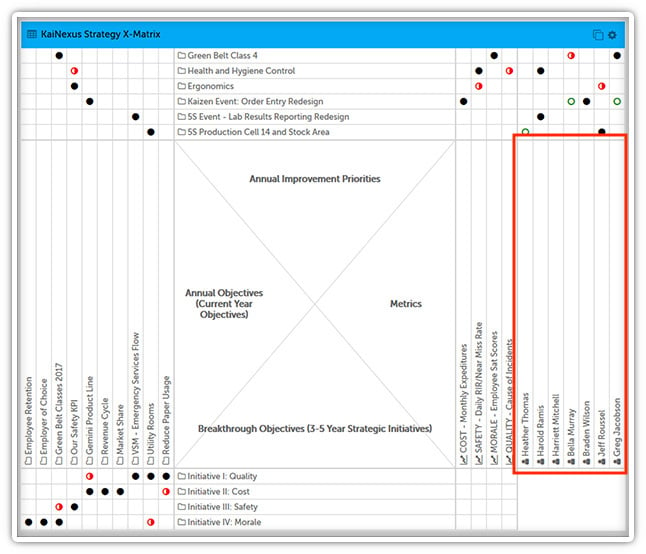 Hoshin Kanri is a strategic planning approach that is often used to improve organizations. Although it is not as commonly used as some other Lean techniques, it is an extremely useful way to ensure that the entire organization is working towards the same ends and moving in the same direction. An organization does not need to be practicing Lean to benefit from Hoshin Kanri, any organization that has embraced the ideas that continuous improvement is essential and that employees should be empowered to create positive change can benefit from the approach.
Hoshin Kanri is a strategic planning approach that is often used to improve organizations. Although it is not as commonly used as some other Lean techniques, it is an extremely useful way to ensure that the entire organization is working towards the same ends and moving in the same direction. An organization does not need to be practicing Lean to benefit from Hoshin Kanri, any organization that has embraced the ideas that continuous improvement is essential and that employees should be empowered to create positive change can benefit from the approach.
What is Hoshin Kanri?
Hoshin Kanri, sometimes also called policy deployment or strategy deployment, is a strategic planning approach that aims to align the strategy (executive level), tactics (middle management), and operations (front-line workers) toward the organization’s “True North,” which are the long-term priorities. This method of management eliminates the waste that comes from poor communication and shifting directions.
The principles of Hoshin Kanri are:
• Focus on the priorities that matter most
• Use Catchball to build plans based on consensus
• Measure progress using thoughtful KPIs that encourage the desired behavior
• Use regular follow-up to monitor and report progress
A Typical Hoshin Kanri Implementation
Perhaps the best way to understand Hoshin Kanri is to walk through the basics of how it is usually implemented. Like many other Lean techniques, much of the effort is front-loaded. Success will depend on how well each step is executed, but the first phase is crucial, so we will spend most of this post on it.
Phase I – Develop the Strategic Plans
A typical Hoshin planning process includes both a long-term and an annual plan. The long-term strategy should consist of three to five breakthrough goals that are necessary to propel the organization to success. They might include things like introducing new products, entering new markets, accelerating growth, or changing the market strategy. These goals will usually take three to five years to achieve. The annual plan includes the shorter-term objectives that are necessary to make the big picture goals a reality.
Keys to Success
Because this phase is so essential, keep in mind these best practices:
- Limit the number of long-term and annual goals. There’s no right or wrong number, but somewhere around five goals works for most organizations. This is important because although listing a ton of goals may feel like progress, diluted efforts and resources lead to less headway and murky priorities.
- Don’t confuse efficiency and effectiveness. It doesn’t pay if you are doing things right (efficiency), but not doing the right things (effectiveness). The long-term and annual goals should be the right things to get the organization close to True North. If a goal doesn’t meet that end, it probably isn’t genuinely strategic.
- Don’t discount incremental progress. Hoshin Kanri requires organizations to walk and chew gum at the same time. The way to achieve breakthrough goals is to make small steps daily. Success doesn’t come overnight; it arrives bit by bit every time an incremental improvement is made.
- Use the Catchball technique to arrive at a consensus. While it is the responsibility of the executive team to develop the strategic plan, teams are more likely to succeed when mid-level managers and others are involved in its development. Catchball is a useful Lean technique for sharing ideas, gaining input, and reaching agreement on the Hoshin plan.
- Use great care when selecting KPIs. Your KPIs are an essential way to determine whether things are going in the right direction. Keep in mind that they drive behavior as well. That which gets measured improves.
- Make sure every goal has an owner. The owner of the goal is responsible for measuring progress and removing any obstacles that get in the way of success.
- Consider an X-matrix. An x-matrix is a powerful tool for aligning strategic priorities, annual goals, and operational tactics. It creates a visual roadmap of the Hoshin plan. (Bonus if you have software to manage it.)

Phase II – Define the Tactics
Once the top-level goals are established, and KPIs are selected, the department or team leaders can create the specific lists of activities they will execute to achieve the goal. The Catchball approach will be relevant again at this phase as mid-level managers and executives toss ideas back and forth to make sure that the tactics are well-aligned with the strategy.
Monthly reviews should be put in place to measure progress because tactics may change to adjust to new conditions or needs.
Phase III – Just Do It
At this point, the strategy and tactics are communicated to the people who will produce results – the front-line employees. Managers work with staff to set individual objectives, using Catchball once again, to ensure that employees feel included in the process and develop a sense of ownership over their goals.
Phase IV – Measure, Report, and Adjust
One thing that makes the Hoshin Kanri process different from other strategic planning exercises is that it is an active process, not just a document. It is essential to have monthly reviews at every level to ensure that forward momentum is maintained. Ideally, improvement software is used to create a dashboard that shows the current state of every KPI. Information should follow freely both up and down the organization so that the strategy is clear to the operators and the current results are clear to the executive team.
Hoshin Kanri helps organizations keep the strategy top-of-mind in the face of daily challenges and other distractions. It gets everyone involved in the plan, increasing employee engagement and accountability. It’s no wonder why an increasing number of organizations are adopting the approach.




Add a Comment